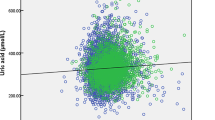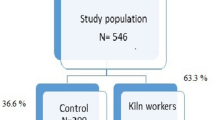Abstract
Estimation of serum copper to indicate copper status in the human system in the context of moderate chronic occupational copper exposure requires a sophisticated and expensive method. Hence, a search for a suitable marker has been made and few studies have found potential in serum ceruloplasmin. In this context, the present study was initiated to explore whether ceruloplasmin could serve as a predictor of occupational copper exposure. An interviewer-administered questionnaire survey (personal, occupational and health-related information) was undertaken involving 185 employees of a copper handling industry. Serum alkaline phosphatase, serum glutamic pyruvic transaminase (SGPT), serum ceruloplasmin and serum copper were estimated in all the subjects. Multivariate analysis was undertaken using a linear regression model to understand the contribution of serum copper on serum ceruloplasmin values adjusting for the role of other confounders. Serum copper and serum ceruloplasmin values were found to have a statistically significant positive correlation (R=0.169, adjusted R2=0.024) after adjustment for other predictors like age, nature of job (department), job duration, smoking, serum alkaline phosphatase and SGPT. This study concludes that the serum ceruloplasmin level can act as a reliable indicator of copper status in the human body following copper exposure in cases of chronic moderate occupational exposure to copper.
This is a preview of subscription content, access via your institution
Access options
Subscribe to this journal
Receive 6 print issues and online access
$259.00 per year
only $43.17 per issue
Buy this article
- Purchase on Springer Link
- Instant access to full article PDF
Prices may be subject to local taxes which are calculated during checkout

Similar content being viewed by others
References
Agency for Toxic Substances and Disease Registry. Toxicological Profile for Copper. United States Public Health Service, 1990.
Agency for Toxic Substances and Disease Registry. Toxicological Profile for Copper 2004: http://www.atsdr.cdc.gov/toxprofiles/tp132-c3.pdf.
Araya M., Olivares M., Pizarro F., Gonzalez M., Speisky H., and Uauy R. Copper exposure and potential biomarkers of copper metabolism. Biometals 2003a: 16: 199–204.
Araya M., Olivares M., Pizarro F., González M., Speisky H., and Uauy R. Gastrointestinal symptoms and blood indicators of copper load in apparently healthy adults undergoing controlled copper exposure. Am J Clin Nutr 2003b: 77: 646–650.
Armstrong C.W., Moore L.W., Hackler R.L., Miller G.B., and Stroube R.B. An outbreak of metal fume fever: diagnostic use of urinary copper and zinc determinations. J Occup Med 1983: 25: 886–888.
Boz A., Evliyaoglu O., Yildirim M., Erkan N., and Karaca B. The value of serum zinc, copper, ceruloplasmin levels in patients with gastrointestinal tract cancers. Turk J Gastroenterol 2005: 6: 81–84.
Bradley D.W., Maynard J.E., Emery G., and Webster H. Clin Chem 1972: 18: 1442.
Davidoff G.N., Votaw M.L., Coon W.W., Hultquist D.E., Filter B.J., and Wexler S.A. Elevations in serum copper, erythrocytic copper, and ceruloplasmin concentrations in smokers. Am J Clin Pathol 1978: 70: 790–792.
Frieden E., and Hsieh H.S. Ceruloplasmin: the copper transport protein with essential oxidase activity. Adv Enzymol Relat Areas Mol Biol 1976a: 44: 187–236.
Frieden E., and Hsieh H.S. The biological activity of ceruloplasmin and its oxidase activity. Adv Exp Med Biol 1976b: 74: 505–529.
Hartmann H.A., and Evenson M.A. Deficiency of copper can cause neuronal degeneration. Med Hypotheses 1992: 38: 75–85.
IPCS Environmental Health Criteria. (1998), World Health Organisation, Copper, Geneva, No.200,89.
Kehoe C.A., Turley E., Bonham M.P., Oconnor M., Mckeown A., Faughan M.S., Coulter J.S., Gilmore W.S., Howard A.N., and Strain J.J. Response of putative indices of copper status to copper supplementation in human subjects. Br J Nutr 2000: 84: 151–156.
Lenntech Water treatment and air purification holding B.V. Health Effects of Copper 2007 http://www.lenntech.com/Periodic-chart-elements/Cu-en.htm.
Linder M.C., and Hazegh-Azam M. Copper biochemistry and molecular biology. Am J Clin Nutr 1996: 63: 797s–811s.
Magalova T., Beno I., Brtkova A., Mekinova D., Volkovova K., Staruchova M., and Tatara M. Levels of Cu, Zn, Se and their relation to levels of ceruloplasmin and the activity of antioxidative enzymes. Bratisl Lek Listy 1997: 98: 8–11.
McLaughlin J.K., Chen J.Q., Dosemeci M., Chen R.A., Rexing S.H., Wu Z., Hearl F.J., McCawley M.A., and Blot W.J. A nested case–control study of lung cancer among silica exposed workers in China. Br J Ind Med 1992: 49: 167–171.
Mendez M.A., Araya M., Olivares M., Pizarro F., and Gonzalez M. Sex and ceruloplasmin modulate the response to copper exposure in healthy individuals. Environ Health Perspect 2004: 112: 1654–1657.
National Research Council. 1980 Copper. In: Recommended Dietary Allowances. Food Nutrition Board, Washington, DC, NRC/NAS, 151-154.
Osaki S., and Johnson D.A. The possible significance of the ferrous oxidase activity of ceruloplasmin in normal human serum. J Biol Chem 1966: 241: 2746–2751.
Poulik M.D., and Weiss M.L., In: Putman F.W. (ed). The Plasma Proteins. Vol. 2, 2nd edn., Academic Press, New York, 1982, pp 52–108.
Suciu I., Prodan L., Lazar V., Ilea E., Cocîrla A., Olinici L., Paduraru A., Zagreanu O., Lengyel P., Gyrffi L., and Andru D. Research on copper poisoning. Med Lav 1981: 3: 190–197.
Twomey P.J., Viljoen A., House I.M., Reynolds T.M., and Wierzbicki A.S. Relationship between serum copper, ceruloplasmin-bound copper in routine clinical practice. Clin Chem 2005: 8: 1558–1559.
Weant G.E. 1985 Sources of copper air emissions. US Environmental Protection Agency, Air and Energy Engineering Research Laboratory (EPA 600/2-85-046), Research Triangle Park, North Carolina.
Wilkinson J.H., and Winsten S. Clin Chem 1969: 15: 487.
Willingham, and Sorenson Tr Elem Med 1986: 3: 139–140.
Acknowledgements
We hereby acknowledge Mr AM Suthar, Mr MM Patel, Mr U Desai, Mr V Rathod, Mr S Dodia and Ms S Patel for their cooperation and help during this study.
We hereby declare that this article is neither published nor under consideration for publication in any other journal. We also confirm that necessary consent was given from the concerned study subjects and the ethical committee as well as the scientific advisory committee of the National Institute of Occupational Health, India. The study was approved by the National Institute of Occupational Health, India.
Author information
Authors and Affiliations
Corresponding author
Additional information
Conflict of interest
The authors state no conflict of interest.
Rights and permissions
About this article
Cite this article
Saha, A., Karnik, A., Sathawara, N. et al. Ceruloplasmin as a marker of occupational copper exposure. J Expo Sci Environ Epidemiol 18, 332–337 (2008). https://doi.org/10.1038/jes.2008.2
Received:
Accepted:
Published:
Issue Date:
DOI: https://doi.org/10.1038/jes.2008.2
Keywords
This article is cited by
-
Time course of pulmonary inflammation and trace element biodistribution during and after sub-acute inhalation exposure to copper oxide nanoparticles in a murine model
Particle and Fibre Toxicology (2022)
-
Analysis of essential and non-essential trace elements in the organs of a mother–fetus pair of spotted seals (Phoca largha) from the Sea of Japan
Environmental Science and Pollution Research (2021)
-
Systemic serum amyloid A as a biomarker for exposure to zinc and/or copper-containing metal fumes
Journal of Exposure Science & Environmental Epidemiology (2018)
-
Blood protein tells copper story
Nature India (2008)



